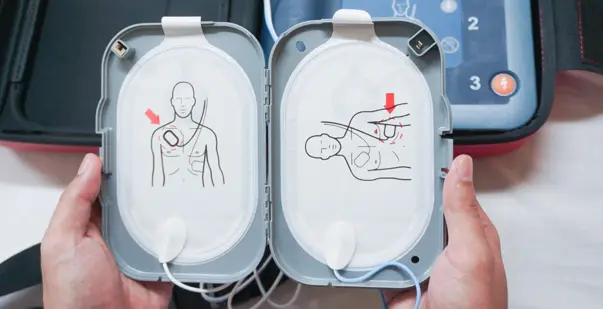Table Of Content(s)
- Introduction
- Why is an AED important?
- On what factors does the cost of an AED depend?
- What are the different types of AEDs and the cost associated with it?
- Conclusion
When considering the purchase of an Automated External Defibrillator, one of the most important questions that crosses our mind is “How much does an AED cost?” AEDs are critical life saving devices that are used to treat sudden cardiac arrests (SCA). When defibrillated on time, the chances of survival increases by 50-74%. Understanding the cost of AEDS is important for both individuals and organizations, who are looking to enhance safety.
The price of an Automated External Defibrillator varies depending on several factors, including brand, features and additional accessories. In this blog, we will break down the costs associated with different automated external defibrillators.
Master ACLS Now
Get ACLS certified with confidence
Why is an AED important?
An Automated External Defibrillator (AED) is a crucial tool in the fight against sudden cardiac arrest. It is a condition where the heart unexpectedly stops beating. AEDs are designed to be simple to use. This makes them accessible to bystanders and non-medical personnel. The immediate use of an AED can significantly increase the chances of survival before emergency medical services arrive. Here’s why an AED is so important:
- Life-Saving Potential: AEDs are designed to deliver an electric shock to the heart, which can restore a normal heart rhythm during sudden cardiac arrest.
- Ease of Use: Most AEDs are user-friendly, with clear instructions and visual aids, allowing even untrained individuals to operate them in an emergency.
- Rapid Response: The quicker an AED is used, the higher the chances of survival. Every minute counts in cardiac arrest situations, and having an AED on hand can make all the difference.
- Widespread Accessibility: AEDs are increasingly found in public places like airports, schools, gyms, and workplaces, ensuring that help is available when needed most.
- Safety Standards: Many organizations and businesses are required to have AEDs on-site to comply with health and safety regulations, further highlighting their importance in emergency preparedness.
- Peace of Mind: An accessible AED provides reassurance to employees, visitors, and the public that they are in a safe environment.
Read More: Cardioversion and defibrillation Overview
What factors determine the cost of an AED?
When purchasing an Automated External Defibrillator (AED), understanding the factors that influence its cost is essential. AED prices can vary significantly based on several key aspects. Knowing what drives these costs will help you make an informed decision and choose the best device for your needs. Here are the main factors that impact the cost of an AED:
- Brand and Manufacturer: Reputable brands may charge more due to their established reliability, customer service, and product quality.
- Type of AED: Different models are available, such as public access AEDs or professional-grade devices, with varying features and corresponding price points.
- Features and Capabilities: Advanced features like CPR feedback, voice prompts, or connectivity to emergency services can increase the price.
- Battery Life and Replacement Costs: The lifespan of the AEDs battery and the cost of replacement batteries are important factors to consider, as they affect long-term expenses.
- Included Accessories: The cost may include essential accessories like carrying cases, extra pads, or pediatric electrodes, which can add to the overall price.
- Warranty and Support: AEDs with longer warranties and more comprehensive customer support options may come at a higher cost but offer added peace of mind.
- Training and Certification: Some AED packages include training materials or access to certification courses, which can influence the overall cost.
- Regulatory Approvals: Devices that meet specific regulatory standards or certifications may be priced higher due to the rigorous testing and compliance required.
- Quantity Purchased: Bulk purchases for organizations or institutions may come with discounts, reducing the per-unit cost of AEDs.
What are the different types of AED and the cost associated with it?
When it comes to Automated External Defibrillators (AEDs), several types are available, each designed for different settings and users. The cost of an AED varies depending on the type and the features it offers. Here’s a breakdown of the different types of AEDs and their associated costs:
1. Public Access AEDs
- Description: Designed for use in public places like schools, airports, gyms, and workplaces, public access AEDs are user-friendly and often feature voice prompts and visual cues to guide laypersons through the defibrillation process.
- Cost: Typically ranges from $1,200 to $2,500.
2. Professional AEDs
- Description: These AEDs are intended for use by medical professionals such as EMTs, paramedics, or healthcare providers. They often include advanced features like manual override, ECG monitoring, and data recording capabilities.
- Cost: Usually ranges from $2,000 to $4,500, depending on the advanced features included.
3. Pediatric AEDs
- Description: Pediatric AEDs are designed specifically to deliver appropriate energy levels for children. Some models include pediatric pads or a key that adjusts the shock level.
- Cost: Prices range from $1,200 to $2,500, similar to public access AEDs, though additional pediatric-specific accessories may increase the cost.
4. Wearable AEDs
- Description: Wearable AEDs, also known as Life Vests, are intended for individuals at high risk of sudden cardiac arrest. These devices continuously monitor the wearer’s heart and deliver a shock if necessary.
- Cost: Typically priced higher, ranging from $3,000 to $6,000, with additional ongoing costs for monitoring services.
5. Implantable Cardioverter Defibrillators (ICDs)
- Description: Although not traditional AEDs, ICDs are surgically implanted devices that monitor and correct heart rhythms. They are usually recommended for patients with severe heart conditions.
- Cost: Costs for ICDs can be significant, often ranging from $25,000 to $50,000, including the device and surgical implantation.
6. Military or Rugged AEDs
- Description: Built to withstand harsh environments, these AEDs are designed for use in extreme conditions, such as in the military, remote areas, or on boats.
- Cost: Typically ranges from $2,000 to $5,000, depending on the durability and features.
Read More: Is ACLS Medical Training Legit?
Conclusion
AED cost varies on several factors. For example, AED prices depend on availability, features and brand. Whether you need a basic public access model or a professional grade device, it is important to consider the environment in which the AED will be used and the people who will be using it. Initially investing in an AED may seem significant, but the value it offers in the long run is immeasurable. So keep the training ongoing, and commit to making this world a safer place to live in.








